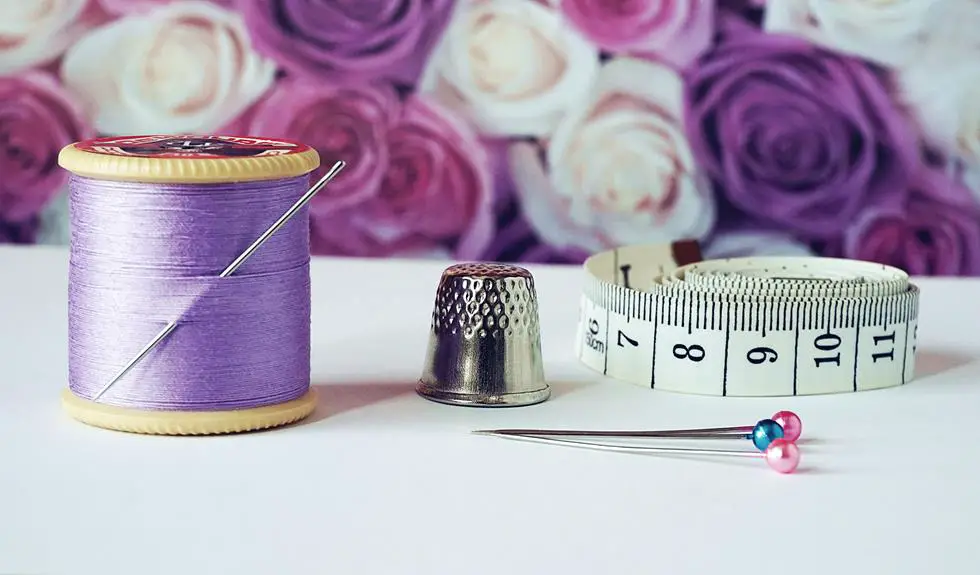When you're starting out with poplin, knowing how to choose the right fabric is crucial for your project's success. You'll want to consider weight and texture, as these factors can significantly impact your final piece. Plus, preparing your fabric properly by pre-washing and ironing can save you from future headaches. But selecting the right tools and techniques can make all the difference in your sewing experience. Let's explore some essential tips that can help you avoid common pitfalls and ensure your project turns out just as you envisioned.
Table of Contents
Key Takeaways
- Pre-wash poplin fabric to remove chemicals and prevent shrinkage before cutting and sewing.
- Use a fine needle and appropriate thread weight to avoid damaging lightweight poplin.
- Choose suitable stitch types, like straight or zigzag, to enhance durability and finish.
- Always align fabric grain properly to ensure flattering drape and prevent distortion.
Choosing the Right Poplin Fabric
When selecting poplin fabric, consider its weight, texture, and intended use to ensure it fits your project perfectly.
Poplin typically comes in various weights, from lightweight to heavier options, so think about what you're making. For garments like shirts and dresses, lightweight poplin offers a nice drape and breathability. If you're working on something sturdier, like a home décor project, opt for a heavier weight.
Next, examine the texture. Poplin usually has a smooth finish, which makes it easy to sew and comfortable to wear. However, some varieties may have a slight sheen or be made from blended fibers, affecting how they feel and behave. You'll want to choose a texture that aligns with your project's aesthetic and functional needs.
Essential Sewing Tools
Having the right sewing tools makes all the difference in your poplin projects, ensuring a smoother and more enjoyable experience.
First, you'll need a trusty sewing machine. Choose one that's user-friendly and has a straight stitch, as poplin is easy to work with and doesn't require intricate settings.
Next, invest in good quality scissors or rotary cutters. Sharp tools make cutting your fabric clean and precise, reducing fraying. Don't forget to grab a cutting mat for safety and accuracy.
You'll also want pins or fabric clips. These help hold your fabric pieces together as you sew, ensuring everything aligns perfectly. A seam ripper is essential too; mistakes happen, and you'll need to fix them easily.
Measuring tools, such as a tape measure and a ruler, are also crucial for accurate cutting and seam allowances.
Lastly, consider a pressing iron. Pressing your seams as you go helps achieve a professional finish.
With these essential tools at your side, you're well-equipped to tackle any poplin sewing project that comes your way!
Preparing Your Fabric
Before you start sewing, it's important to prep your poplin fabric properly to ensure the best results.
Begin by washing your fabric, even if it's labeled as pre-shrunk. This step removes any chemicals and helps prevent future shrinkage. Use cold water and a gentle cycle, then hang it to dry or tumble dry on low.
Next, iron your fabric to get rid of any wrinkles. Poplin can be prone to creasing, so a good press will make cutting and sewing much easier. Set your iron to a medium heat and use steam if necessary, but always check the care label for specific instructions.
Once your fabric is clean and smooth, it's time to cut. Lay it flat on a clean surface, ensuring the grain is straight. Use sharp scissors or a rotary cutter for clean edges. Don't forget to pin your pattern pieces before cutting to avoid any shifting.
Understanding Stitching Techniques
When you start sewing with poplin, it's crucial to understand the essential stitch types that work best with this fabric.
You'll also want to select the right thread and needle to ensure your seams hold up well.
Lastly, mastering seam finishing techniques will help you achieve a polished look in your projects.
Essential Stitch Types
Understanding essential stitch types is crucial for mastering poplin sewing, as each stitch serves a specific purpose and can significantly impact your project's outcome. Choosing the right stitch will enhance the durability and appearance of your finished piece.
Here are four essential stitch types you should know:
- Straight Stitch: This is the most common stitch, perfect for seams. It provides a strong hold and is ideal for most poplin projects.
- Zigzag Stitch: Use this stitch for finishing edges to prevent fraying. It's also great for stretch fabrics, making it versatile for various sewing tasks.
- French Seam: This is an excellent choice for lightweight fabrics like poplin. It encloses raw edges, giving a neat finish, perfect for garments or delicate items.
- Topstitch: Applying a topstitch adds a decorative touch while reinforcing seams. It's great for hems and can elevate the look of your project.
Familiarizing yourself with these stitch types won't only improve your sewing skills but also ensure that your poplin creations look professional and last longer.
Thread and Needle Selection
Choosing the right thread and needle is essential for achieving the best results when sewing with poplin. Poplin is a lightweight fabric, so you'll want to use a fine needle, typically a size 70/10 or 80/12. This helps prevent damage while ensuring smooth stitching. A universal needle works well, but you can also opt for a microtex needle if you're working with finer poplin.
When it comes to thread, choose a polyester or cotton-polyester blend. These threads provide strength and flexibility, making them ideal for poplin's texture. A weight of 50 or 60 is usually perfect for most projects. Avoid heavy threads, as they can create bulk and distort your seams.
As you sew, keep your tension balanced. If the thread pulls too tight, it can ripple the fabric, while too loose can lead to fraying. Test your thread and needle combination on a scrap piece of poplin before starting your project.
This way, you can ensure you're getting the right stitch quality. With the proper thread and needle, you'll find that sewing with poplin becomes a smooth and enjoyable experience.
Seam Finishing Techniques
Finishing seams properly is crucial for preventing fraying and ensuring your poplin projects look polished and professional. There are several techniques you can use to achieve this, making your sewing experience easier and your finished products more durable.
Here are four effective seam finishing methods you should consider:
- Zigzag Stitch: Use a zigzag stitch along the raw edges to prevent fraying. This technique is quick and works well with the lightweight nature of poplin.
- French Seams: For a clean look, try French seams. They enclose the raw edges, making them invisible and adding strength to your seams.
- Bias Binding: If you're looking for a decorative finish, consider using bias binding. This will give your seams a pop of color while preventing fraying.
- Overlocking: If you have an overlocker (serger), use it to finish your seams quickly and effectively. This will provide a professional finish that keeps your seams secure.
Finishing Touches
Adding the right finishing touches to your poplin project can elevate its look and ensure durability.
Start by giving your seams a final press. This not only smooths out any wrinkles but also helps set the stitches, making them more secure. Use a pressing cloth if necessary to avoid damaging the fabric.
Next, consider adding topstitching along the edges or seams. This technique can enhance the visual appeal while providing extra strength. Choose a contrasting thread color to make the stitching stand out, or match it for a subtle finish.
If your project includes hems, don't forget to finish them neatly. You can use a blind hem stitch for a professional look or simply fold and stitch it down for a clean finish. Adding bias tape or a decorative trim can also give your hem an extra flair.
Common Mistakes to Avoid
When sewing with poplin, it's easy to make a few common mistakes that can affect your project.
You might forget to pay attention to the fabric grain direction, skip pre-washing, or overlook seam finishing techniques.
Avoiding these pitfalls will help ensure your sewing experience is smooth and successful.
Ignoring Fabric Grain Direction
Ignoring fabric grain direction can lead to distorted shapes and uneven seams in your poplin projects. Understanding how to align your patterns with the fabric grain is crucial for a polished finish.
Here are four key reasons to pay attention to grain direction:
- Stability: Cutting along the grain provides stability and helps your garment maintain its shape.
- Drape: The way fabric hangs is affected by grain direction. Proper alignment ensures a flattering drape.
- Stretch: Poplin has some stretch, and ignoring the grain can result in stretching that alters your design.
- Seam performance: Seams that aren't aligned with the grain can lead to puckering and uneven edges, making your project look unprofessional.
To avoid these issues, always identify the grain lines on your fabric before cutting.
Use pattern weights or pins to secure your pattern pieces, ensuring they align correctly. Taking a few moments to check grain direction can save you time and frustration later on.
Skipping Pre-Washing Steps
Many beginners make the mistake of skipping pre-washing their poplin fabric, which can lead to unexpected shrinkage and color bleeding after you've invested time into your project.
Pre-washing is essential because it helps to remove any chemicals or finishes that may be present on the fabric. These residues can affect how the fabric behaves during sewing and wearing.
When you pre-wash, you also give your fabric a chance to shrink before cutting your pattern pieces. If you skip this step, you might find that your finished garment doesn't fit as expected after the first wash. Additionally, colors can bleed when the fabric gets wet for the first time, potentially staining other fabrics.
To pre-wash effectively, simply toss your poplin in the washing machine with a mild detergent. Use cold water to minimize shrinkage, and hang it to dry or tumble dry on low. Iron it if needed before you start cutting your patterns.
Taking this simple step not only ensures a better fit but also improves the durability and appearance of your finished project. So don't skip this crucial phase; your future self will thank you!
Overlooking Seam Finishing Techniques
Skipping over proper seam finishing techniques can lead to frayed edges and a less polished look in your final project. It's essential to pay attention to these details, especially when working with poplin, which can fray easily. Here are some common mistakes to avoid:
- Ignoring the Importance of Finishing: Always finish your seams to prevent unraveling. Techniques like zigzag stitching or using a serger can save you from future headaches.
- Not Using the Right Stitch: Make sure you're using a stitch that suits the fabric. A straight stitch mightn't hold as well on a bias seam, so consider a zigzag or a stretch stitch when needed.
- Neglecting Pressing: Press your seams open or to one side as you sew. This helps flatten the fabric and achieve a neat finish.
- Forgetting to Trim Threads: After sewing, always trim any excess threads. This small step makes a big difference in the overall appearance of your project.
Frequently Asked Questions
Can I Use a Regular Sewing Machine for Poplin?
Yes, you can use a regular sewing machine for poplin. Just ensure your needle is sharp and your tension is adjusted correctly. With the right settings, you'll achieve smooth, neat seams on your fabric.
How Do I Pre-Wash Poplin Fabric Before Sewing?
To pre-wash poplin fabric, you'll want to machine wash it in cold water with a gentle cycle. After washing, tumble dry on low or hang it up to dry. This helps prevent shrinking later.
Is Poplin Suitable for Children's Clothing?
Yes, poplin's lightweight and breathable nature makes it perfect for children's clothing. Its softness ensures comfort, while the fabric's durability withstands active play. You'll appreciate how easy it is to care for too!
What Type of Thread Works Best With Poplin?
When working with poplin, you'll want to use a high-quality cotton or polyester thread. These threads provide durability and strength, ensuring your seams hold up well while maintaining the fabric's crisp appearance.
Can I Iron Poplin Fabric, and at What Temperature?
Yes, you can iron poplin fabric. Set your iron to a medium heat, around 300°F (150°C). Always use a pressing cloth to protect the fabric, and avoid using steam to prevent water spots.
- Where to Buy Sherpa Suede Fabric - July 12, 2025
- How to Draw or Illustrate the Texture of Suede Fabric - July 12, 2025
- What Is Baseball Suede Leather Fabric? - July 12, 2025







